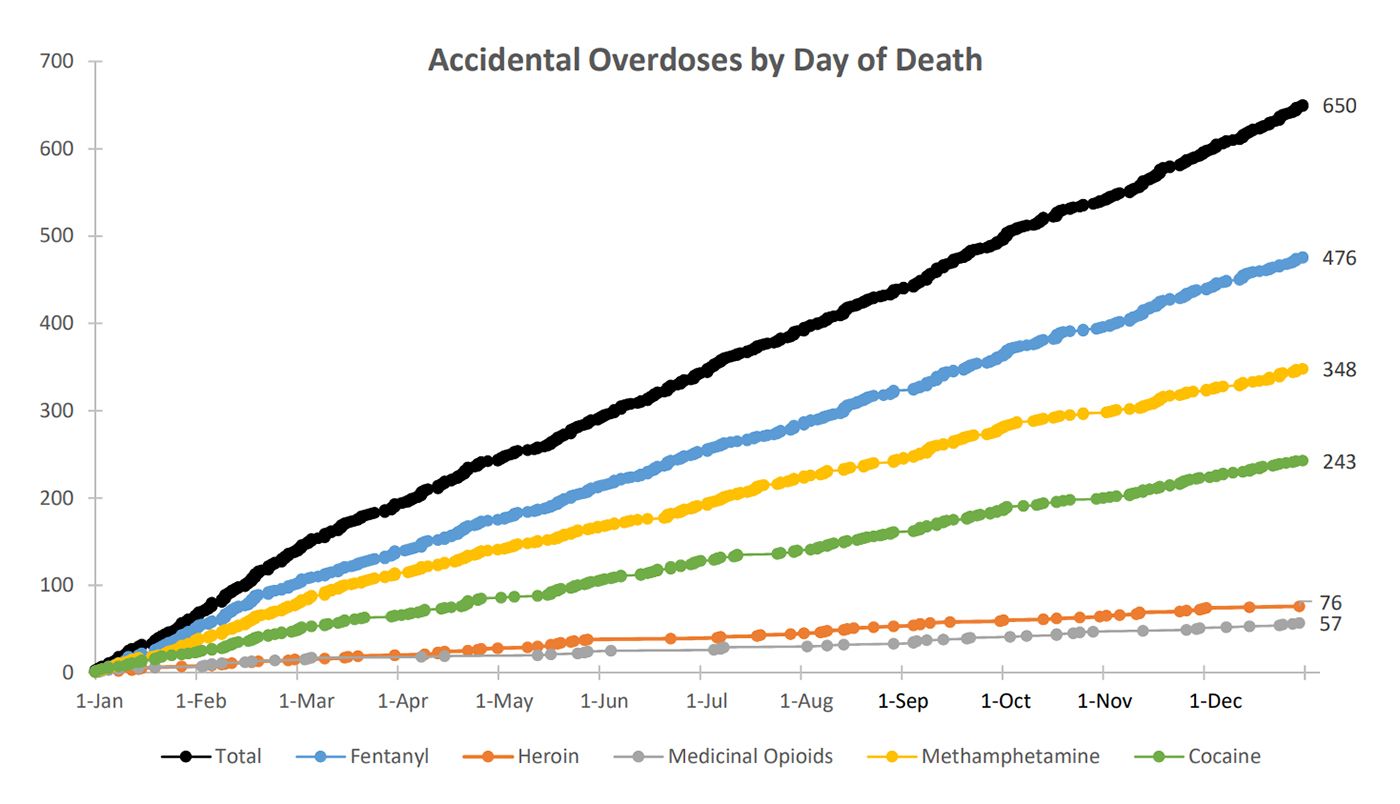Overdose deaths from fentanyl and other drugs in San Francisco went down for the first time in three years according to new data for 2021, marking what experts hope is a leveling off in accidental drug deaths thanks to public-health interventions.
The SF Department of Public Health on Wednesday released its Accidental Overdose Report for 2021, and preliminary data shows that overdose deaths in the city declined from 700 in 2020 to 65o in 2021 — a small but potentially meaningful drop of 7%. The department and Mayor London Breed are looking to credit the city's substance-use and mental health treatment programs, as well as housing and other services for hopefully turning the corner on the opioid overdose crisis. And likely a major has been the widespread use and distribution of naloxone, the life-saving overdose-reversal drug.
In 2020 and 2021, the city launched the Street Overdose Response Team (SORT) and the SRO Overdose Prevention Program, both targeting individuals at high risk for overdose. Also, the city and its community partners established 150 "low-barrier" naloxone stations, some at 30 different sites that were established for pandemic sheltering in place.
"We grieve the many lives lost to overdose in 2021 and commit ourselves to employ the tools, resources, and support that we know are effective to save lives," said Dr. Grant Colfax, the city's director of health, in a statement. "We also show our gratitude for the many people who saved a life this past year, reversing an overdose, connecting someone to treatment, or being a steadying hand in a friend’s path to wellness."
Dr. Colfax added, "We look to 2022 with optimism and hope given the many efforts and resources being deployed at a rapid pace and the commitment of our communities and partners throughout the City to save lives."
Of the 650 total overdose deaths, fentanyl was a factor in 476 cases, according to the new report. Methamphetamine, sometimes in combination with fentanyl or other drugs, was a factor in 348 cases, and cocaine a factor in 243 cases. Heroin was the least-implicated drug in 2021 when it came to overdose deaths. 40% of the overdose deaths occurred in the Tenderloin and SoMa combined.

The SFPD would probably also like to get credit for removing some of the fentanyl from the streets last year. Cops in the Tenderloin seized four times as much fentanyl in 2020 as they had in 2019 — and the drug, which is 50 times more potent than heroin and can cause an overdose in a minuscule amount, has become more popular than other opioids and maybe even heroin itself in the last four years. Last May, the SFPD said it was on track to seize four times as much fentanyl as in 2020, but experts said this was likely only make a small dent in the supply.
But any decline in deaths is good, and things were already looking up when a six-month reports came out in July showing 344 overdose deaths between January and June — a slight decline from 2020's rate — with naloxone having been used 4,235 times to prevent deaths.
With 1,350 overdose deaths in the past two years, most of them from fentanyl, it remains true that fentanyl has killed many more people than COVID in San Francisco — to date, nearly twice as many, in fact in these past two years.
"As we continue to implement Mental Health SF and invest in critical services like our Street Overdose Response Team, we must look ahead and build on the progress we have," said Mayor Breed in a statement. "We know that every overdose death is preventable, and we know that we still have a long way to go, but we must act aggressively to ensure that every resident receives the support and services they so desperately need."
Breed has touted the establishment of a drug sobering center, now dubbed SoMa RISE, which we learned last spring was headed for a space at 1076 Howard Street — however this center is likely to be primarily used for individuals high on meth who need a space to safely come down that is neither a hospital nor a jail.
Also coming in 2022, according to the Department of Public Health, are an expansion of the Street Overdose Response Team to include more peer specialists; the addition of more beds and treatment facilities; and the launch of a fentanyl test-strip program, so that drug users can test their drugs for fentanyl contamination.
Previously: Report: Pandemic Leads To Epidemic of Fentanyl Overdoses In SF
Photo by Scott Olson/Getty Images

